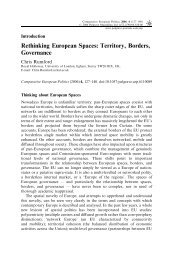Europeanisation, National Identities and Migration ... - europeanization
Europeanisation, National Identities and Migration ... - europeanization
Europeanisation, National Identities and Migration ... - europeanization
You also want an ePaper? Increase the reach of your titles
YUMPU automatically turns print PDFs into web optimized ePapers that Google loves.
6 <strong>Migration</strong>, cultural<br />
diversification <strong>and</strong><br />
<strong>Europeanisation</strong><br />
Krystyna Romaniszyn<br />
Introduction<br />
This chapter expounds a thesis coined by the author (Romaniszyn 1999a, 2000a)<br />
holding that international migrations amplify the cultural diversity of an ‘affected’<br />
society, be it a recipient or a sending one. The following analysis aims to supply yet<br />
another dimension for the discussion of the process of <strong>Europeanisation</strong> highlighted<br />
in this book. The analytical scope of the text embraces cultural changes brought<br />
about by the international inflows in the in-migration <strong>and</strong> out-migration countries<br />
in the areas of: work, organisation, <strong>and</strong> consumption patterns; social norms <strong>and</strong><br />
social status; local communities; collective <strong>and</strong> individual identities, ethnic<br />
stereotypes, interethnic relations, <strong>and</strong> ethnic structure.<br />
The chapter is in three main parts. It begins by outlining basic developments<br />
regarding international inflows into Europe. Next follows the presentation <strong>and</strong><br />
discussion of the impact of migration on the above-specified aspects of culture 1 of<br />
the host <strong>and</strong> sending countries. It concludes by considering dilemmas regarding<br />
the management of cultural pluralism resulting from international inflows, <strong>and</strong> how<br />
this relates to <strong>and</strong> influences the process of <strong>Europeanisation</strong>.<br />
The besieged fortress of Europe<br />
Mass international migrations have accompanied the history of Europe for the past<br />
century. During that time the map of the receiving regions <strong>and</strong> those where the<br />
migration pressure had been built up has changed dramatically. In the last few<br />
decades the formative factors which have strongly influenced the migratory<br />
movements on the European continent included a cessation of the foreign labour<br />
recruitment programmes, the collapse of the Soviet bloc, European integration,<br />
<strong>and</strong> the globalisation processes. The factors at work have resulted either in<br />
generating migratory pressure – a tendency that prevails – or in counteracting it.<br />
Generally, the response of the European Union member states to the increased<br />
migration potential is characterised by the implementation of restrictive <strong>and</strong><br />
exclusionary immigration policies <strong>and</strong> the adjustment of the monitoring system in<br />
order to protect these countries against uncontrolled immigration, <strong>and</strong> to curb<br />
controlled immigration. These new immigration politics have very quickly been<br />
accused of creating a ‘Fortress Europe’. The metaphor generated another one,



